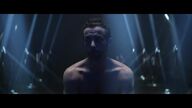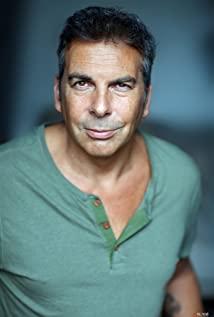The film begins with the artist's manifesto: I turn him into a commodity, a canvas, so that he can cross the walls of national borders. Now the flow of commodities is more free than the flow of human beings, and I have turned him into a commodity, so that he can restore his humanity and freedom according to the rules of the times in which we live. This is so contradictory, right?
Indeed, the film shows the movement of the refugee (crossing national borders) at the expense of his stillness (displayed as a sculpture in the exhibition hall), and when his body is alive and when it is still, it is up to the high society to see. Alienation is over.
The artist's practice is also very simple: through the inscription of the body to turn people into objects, a materialization of Orientalism is carried out. This materialization is not only tattoos, but also includes visas, contracts and other civilized world passes. It should be noted that this is more of a parody experiment/game for artists who are in the field of the system and understand the rules of the game. The artist assistant is a woman, and her identity is a pacifier, more of a kind of emotional labor, deceiving and guiding through the ingenious liberal discourse of "the world is yours".
For Sam, it was during the exhibition that he gradually realized that he sold more than just skin and body, and experienced a process from "unknown/unperceived" to "knowing/perceiving". In a workplace filmed by high-class people, Sam "unruly" asked to send his picture to his mother. The artist only cares about his sarcasm, the photographer only cares about the effect of the photo, making the male protagonist bow his head and call him good boy. Only the pacifier pays attention and responds to his emotional needs, taking pictures she thinks are beautiful with her mobile phone. But Sam couldn't be satisfied, because there was no son's face for his mother to see in the photo, but his freshly curious back. When the students visited him, they asked whether all people from afar had this totem. If the tattooing process is the realization of the symbolic meaning of the totem by falling into the flesh, then at this moment, the symbolic meaning of the totem has entered the viewer's mind through the traveling exhibition. structure.
Sam's dual nature as a human being and a commodity and the tension between the two are highlighted. On the one hand, it is exhibited as an object, and on the other hand, it is perceived and involved as an actor. Beginning with a very simple motive (love), lured by the dream of liberalism, thinking that he is almost famous, wearing a silk robe and walking like a master in the art gallery, but gradually realizes in the exhibition that it is not him who is valuable. It's the skin of his back, he's just a painting to them, he's lost a lot of what he is as a human being, and the feeling of being exploited is coming to the fore. In the process, the artworks in the museum, which are also still lifes, evoke his memory as a human: the animals in the painting are frozen, and the viewer is the canvas (the bearer of the tattoo art skin), watching the frozen dead Animals, people who exhibit as objects are awakened by vivid memories of the love life of the past hometown. This detail is very elegant, and the text is still very carefully crafted.
On the other hand is the issue of nationality, where fellow compatriots abroad (who are also exiles) are indifferent to Sam's exploitation at home (issues of class, etc.) and see only an insult to the group. However, what is even more cruel is that even this kind of anger is not allowed, and the conflict has created a chain of bowing: having high power at home but causing trouble abroad, asking his wife and Sam (his rival in love) to bow their heads and make Sam Mu bowed his head to plead with the upper class. In the face of domestic high pressure, the male and female protagonists also rely on betrayal of their bodies (there is no essential difference between marrying him and running away from being tattooed and running away) to come to the other side of the high wall, but on the other side they are either things or second-class. citizen. Mother's suffering in her hometown is in stark contrast to the rhetoric of arty merchants in art museums: We people in the first world have given you a choice, either endure the war and suffering, or come and be sold by us like livestock and goods . To control, sell, and insure people as objects, the arrogance of people in the "civilized world" is vividly displayed.
After being engaged by the "civilized people", Sam quickly learned to use these rules as his bargaining chip, and was no longer willing to make a painting and meat on a chopping board. The confrontation with the barbarian was very exciting. The curator was terrified of the instability of the artwork, and was dissatisfied with being contradicted by an object that could speak. The barbaric method was ineffective against him, but the "human rights" card could still be played a dozen times. At least political correctness can also be used as a weapon of Sam's self-defense.
What the artist said in an interview was later confirmed. He endowed the human body with no meaning (beyond the body itself) as an item of value, and sent it to the auction table for art auctions. He also admitted that it was human trafficking in an artistic fig leaf. At the auction, the sad face of the male protagonist and the terrorist-like symbolic body posture, that section is indeed very square.
The ending has been reversed several times: the first is a reversal of the artist's prophecy (in order to become a human being first becomes a thing), in order to become a human again, Sam's obligation to leave the country and not fall into prison is ultimately unfulfilled. The second time is a love story and a relationship reversal, in another country, Sam and his sweetheart speaking their native language, happily banished from the land of civilized people, an assistant to emotional labor on the farewell phone (simply is a nanny) saying take care of yourself is also a backlash to take care of artwork. The third time is a power reversal similar to Shuangwen. Here, the artist's game is revealed. Only by becoming an object can you become a person, and you can only live when you die. In fact, he is not attacking the system but playing the system. He is an ironic artist living in the consumer society system, in which, being ignored, he has also made Sam feel it.
The whole film is very clever and ingenious, with a strong sense of humor and drama. From the perspective of music and pictures, it is an attempt to use current social issues to shoot contemporary tragedies, both on body and national issues (refugees, body workers). Involved, showing a little humanitarian care just right (with a touch of water), and also standing up all the round figures. For example, although the artist is ironic and seems to be in love with the male protagonist, he is concerned about the health of the skin (that is, the artwork's exhibition value) is better than caring for people, this part is not the last sentence you can reconcile if you are free. For example, a female assistant, she has multiple roles, one is to care for the artwork (the artist is furious at her because of Sam’s skin condition), the other is to take care of Sam’s emotions, taking care of his daily life like a nanny, and at the end because of Sam's suspended animation brought tears to his eyes.
Of course, the failure is also reversed for the third time. This reversal of "I have always been free" is too cool and too self-deceiving. Not only does it fail to point out that this so-called freedom depends on dealing with the system and making business games The accumulated luck of gambling has a placebo effect, and there is a feeling of using social issues but whitewashing the real problem, and the intensity of criticism and irony has also declined.
From this point of view, although it is not a reversal for the sake of reversal, it is just a lot of suspense, and finally it focuses on the ironic game of nihilistic artists, which is somewhat bad. I can't help but wonder if this director will overlap himself with the artist in the film. He is so smart and ingenious, and he knows the rules of the game in the art field. .
View more about The Man Who Sold His Skin reviews











